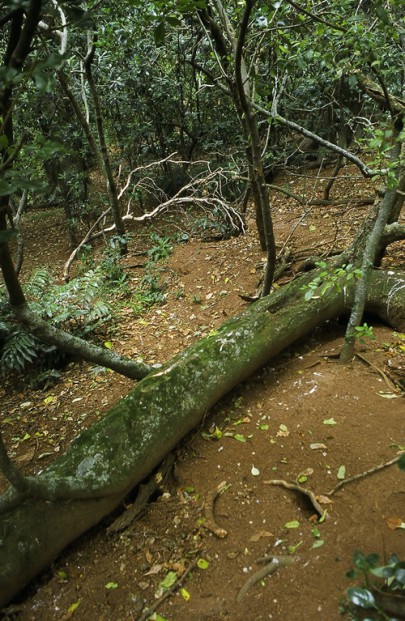Seabird-burrowed soils
In this section

Middle Island in the Mercury Group (Peter Bellingham)
These areas are where soils have been disturbed and enriched by seabirds burrowing for nesting, track formation, and guano (excrement). Bird colonies may be in the open with almost no vegetation and only a few nitrophilous plants (e.g. Disphyma australe), beneath low-growing scrub (e.g. Muehlenbeckia complexa) or tussock grasses, or beneath a low forest where the birds simply drop through the canopy onto the forest floor where the cover of vegetation is proportional to the amount of bird activity.
Notable flora and fauna
Threatened plants include the nationally critical native hibiscus (Hibiscus richardsonii), and coastal peppercress (Lepidium banksii); the nationally vulnerable coastal cress (Lepidium flexicaule), Lepidium naufragorum, nau (Lepidium oleraceum) and New Zealand water cress (Rorippa divaricata). Declining species include Cyperus insularis. Relict species includes orache (Atriplex australasica), rengarenga lily (Arthropodium bifurcatum), William’s broom (Carmichaelia williamsii), Chatham Island button daisy (Leptinella featherstonii) and large-leaved milk tree (Streblus banksii). Naturally uncommon species include Buchanan’s orache (Atriplex buchananii), sand brome (Bromus arenarius), Senecio carnosulus, Senecio marotiri, Mokohinau groundsel (Senecio repangae subsp. pokohinuensis) and Senecio repangae subsp. repangae. Vagrant species include Senecio australis and the coloniser species include devils horsewhip (Achyranthes velutina) and mawhai (Sicyos australis).
Many petrel species create burrows, including the range restricted Pycrofts petrel (Pterodroma pycrofti) and Westland black petrel (Procellaria westlandica), and gradually declining Cook’s petrel (Pterodroma cookii), and black petrel (Procellaria parkinsoni).
Tuatara (Sphenodon spp.) are present, sometime co-habiting with birds, on some islands. There are several forms: nationally endangered Brothers island tuatara (S. guntheri), range restricted Cook Strait tuatara (S. punctatus 'Cook Strait') and sparse northern tuatara (S. punctatus subsp. punctatus).
Other threatened vertebrates associated with seabird burrows include Whitaker’s skink (Oligosoma whitakeri) and the robust skink (Oligosoma alani).
Threat status
Critically endangered (Holdaway et al. 2012)
Threats
High-fertility sites are invaded by weeds such as barley grass (Hordeum spp.) and annual exotic herbs spreading from surrounding areas, including via bird dispersal. These ecosystems are vulnerable to serious depletions of burrowing birds and other native fauna due to predation by rats, cats, and stoats. Sites with sparse and low vegetation cover pose little risk of fire, but forested sites may burn. The seabirds themselves are also at risk from being caught in fishing trawlers and from declining fish stocks on which they feed. Invasive mammals like rats also predate the chicks.
Where do they occur?
These systems may not have been naturally uncommon, because they would once have been widely distributed on the New Zealand coast, as far inland as the mountains of Te Urewera, and as high as the slopes of the Seaward Kaikoura Range, where they still exist. Now they are largely confined to islands, from the far northern New Zealand to the subantarctic. There are at least 22 in the Auckland Region alone.
Further reading
Gilham ME 1960. Plant communities of the Mokohinau Islands, northern New Zealand. Transactions of the Royal Society of New Zealand 88: 79-98.
Hawke DJ, Holdaway RN, Causer JE, Ogden S 1999. Soil indicators of pre-European seabird breeding in New Zealand at sites identified by predator deposits. Australian Journal of Soil Research 37: 103-113.
Mulder CPH, Grant-Hoffman MN, Towns DR, Bellingham PJ, Wardle DA, Durrett MS, Fukami T, Bonner KI 2009. Direct and indirect effects of rats: does rat eradication restore ecosystem functioning of New Zealand seabird islands? Biological Invasions 11:1671-1688.
QEII National Trust. 2009. Seabirds: the impact of rats on their activities and the flow-on effects on ecosystems. Open Space 77: 16-17.
Roberts CM, Duncan RP, Wilson KJ 2007. Burrowing seabirds affect forest regeneration, Rangatira Island, Chatham Islands, New Zealand. New Zealand Journal of Ecology 31: 208-222.
Towns DR 1992. Recovery plan for Whitaker’s skink and robust skink. Threatened Species Recovery Plan Series No. 3. Wellington, Department of Conservation. 48p.
Towns DR, Wardle DA, Mulder CPH, Yeates GW, Fitzgerald BM, Parrish GR, Bellingham PJ, Bonner KI 2008. Predation of seabirds by invasive rats: multiple indirect consequences for invertebrate communities. Oikos 118: 420-430.
Wardle DA, Bellingham PJ, Fukami T, Mulder CPH 2007. Promotion of ecosystem carbon sequestration by invasive predators. Biology Letters 3:479-482.
Links
Rod Morris Photography. Brothers Island tuatara (Sphenodon punctatus) male sharing burrow with fairy prion chick


